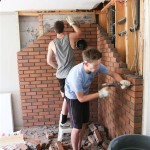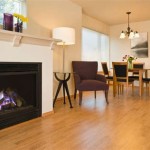Flat Stone for Fireplace: Material Selection, Installation, and Applications
Flat stone, utilized for fireplace construction and design, offers a blend of aesthetic appeal, durability, and fire resistance. The selection of appropriate flat stone significantly impacts both the visual character and functional performance of a fireplace. This article explores the key considerations involved in choosing and installing flat stone for fireplaces, encompassing material properties, design considerations, and best practices for ensuring structural integrity and safety.
Material Properties and Selection Criteria
The suitability of flat stone for fireplace applications hinges on its inherent material properties. Critical factors include heat resistance, density, porosity, compressive strength, and aesthetic qualities. Certain types of natural stone inherently possess superior heat resistance, crucial for withstanding the high temperatures produced within a fireplace firebox.
Granite, for example, is a dense, igneous rock known for its excellent heat resistance and durability. Its relatively low porosity minimizes the risk of water absorption and subsequent cracking due to freeze-thaw cycles, making it suitable for both interior and exterior fireplace applications. However, granite can be more expensive than other stone options. Colors also vary widely.
Slate, a metamorphic rock, offers a distinctive layered appearance and good heat resistance, though it may be more susceptible to chipping or flaking compared to granite. Slate exhibits a wider range of natural cleavages, making it relatively easy to split into thin, flat slabs suitable for facing fireplace surrounds and hearths. The darker colors available in slate often create a dramatic and contemporary look. However, slate can be prone to scratching.
Limestone and sandstone, sedimentary rocks, offer a warmer, more natural aesthetic. However, they tend to be more porous than granite or slate, potentially leading to staining or damage from prolonged exposure to moisture or soot. Sealing these types of stone is essential to protect them from the elements, as well as regular cleaning.
Manufactured stone veneer presents an alternative to natural stone. These products are typically made from a concrete mix that is molded and colored to resemble natural stone. Manufactured stone offers a lighter weight and often lower cost than natural stone, making it easier to install. While manufactured stone can be designed to be fire-resistant, it’s crucial to verify the manufacturer’s specifications and ensure the product is rated for fireplace applications. Improper use can cause the veneer to crumble and damage the fireplace.
Color and texture play a significant role in the aesthetic impact of the fireplace. Darker stones, such as black slate or charcoal granite, tend to create a more dramatic and modern look, while lighter-colored stones, like beige sandstone or cream-colored limestone, can evoke a sense of warmth and tradition. The texture of the stone, ranging from smooth and polished to rough and textured, further contributes to the overall visual character of the fireplace. Regardless of the stone selected, it should complement the existing architectural style and interior design of the space.
Size and shape are also primary considerations. Flat stones are commonly available in various sizes and shapes, from small, rectangular tiles to large, irregular slabs. The size and shape of the stone should be proportionate to the scale of the fireplace and the surrounding wall. Large slabs can create a more monolithic and contemporary look, while smaller tiles can provide a more intricate and detailed appearance.
Design Considerations and Installation Techniques
Proper fireplace design and installation are crucial for both aesthetic appeal and functional safety. The fireplace should be designed and constructed in accordance with local building codes and regulations, taking into account factors such as fire safety, ventilation, and structural integrity.
The fireplace hearth, the non-combustible area in front of the firebox, should be constructed using fire-resistant materials, such as flat stone, to protect the surrounding floor from sparks and embers. The hearth must extend sufficiently far enough from the firebox opening to catch any escaping embers. Building codes typically specify minimum hearth dimensions based on the size of the firebox opening.
The fireplace surround, the decorative facing around the firebox opening, can be constructed using a variety of materials, including flat stone. The surround should be securely attached to the fireplace structure using appropriate adhesives and anchoring techniques. It should also be designed to allow for thermal expansion and contraction, to prevent cracking or movement of the stone. Mortar joints should be appropriately sized and filled to prevent smoke or gases from escaping.
Proper installation of flat stone requires careful preparation of the substrate, the surface onto which the stone will be applied. The substrate should be clean, dry, and structurally sound. A cement-based mortar is typically used to adhere the flat stone to the substrate. The mortar should be mixed according to the manufacturer's instructions and applied evenly to the back of the stone.
When installing flat stone, it is essential to maintain consistent joint spacing between the stones. This not only enhances the aesthetic appearance but also allows for thermal expansion and contraction. Joint spacing can be achieved using spacers or by carefully aligning the stones during installation. Mortar joints should be filled with a flexible, fire-resistant grout to prevent water penetration and ensure a durable, long-lasting installation.
For larger flat stone slabs, mechanical anchoring may be necessary to provide additional support. Anchors can be embedded in the substrate and attached to the back of the stone using epoxy or other suitable adhesives. It is crucial to consult with a structural engineer to determine the appropriate anchoring system for specific fireplace designs and stone types.
Maintenance and Safety
Regular maintenance and inspection are essential for ensuring the continued performance and safety of a flat stone fireplace. The fireplace should be cleaned regularly to remove soot, ash, and other debris. A soft brush and mild detergent can be used to clean the stone surface. Avoid using harsh chemicals or abrasive cleaners, as these can damage the stone. Clean with a damp cloth and dry completely.
Inspect the fireplace regularly for any signs of cracking, spalling, or other damage. Cracks in the stone or mortar joints should be repaired promptly to prevent water penetration and further deterioration. Any loose or damaged stone should be re-secured or replaced. Check the flue is also working properly.
Ensure that the fireplace damper is functioning properly to prevent drafts and ensure proper ventilation. Have the chimney inspected and cleaned annually by a qualified chimney sweep to remove creosote buildup and prevent chimney fires. Creosote build-up is a fire hazard.
When using the fireplace, always follow the manufacturer's instructions and safety guidelines. Never leave a fire unattended, and always use a fire screen to prevent sparks from escaping. Keep combustible materials away from the fireplace opening. Ensure adequate ventilation in the room to prevent carbon monoxide buildup. Install carbon monoxide detectors in the home and check them regularly.
Flat stone offers a versatile and attractive material option for fireplace design and construction. By carefully selecting the appropriate stone type, employing proper installation techniques, and implementing a regular maintenance program, homeowners can create a beautiful and safe fireplace that will provide years of enjoyment.

Stone Veneer Fireplace Design Your Perfect Space

Flat Stone Fireplace Surround With Mantel To The Floor Painted Mantels Designs Family Room Design

Natural Stacked Stone Veneer Fireplace Ideas

Stone Veneer Fireplace Design Your Perfect Space

Pin On Woodworking

8 Reasons To Build Your Fireplace With Manufactured Stonestone Selex

How To Build An Outdoor Stacked Stone Fireplace

Foyer Intérieur Design D Aménagement Avec Parement Pierre Naturelle Inspirationmaison Idma Home Fireplace Brick Makeover Remodel

Diy Stacked Stone Fireplace Reveal And How To Thrifty Decor Organizing

11 Stone Veneer Fireplace Surround Design Trends Where To Buy
Related Posts








